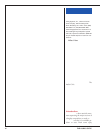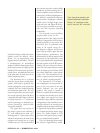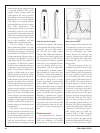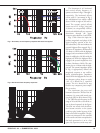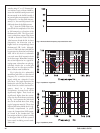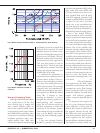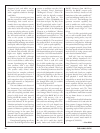
22 THE AUDIO CRITIC
fr
equency, level, and width, are on
the front of each system, accessible
with
a supplied screwdriver through
small
holes.
N
ow to the interesting part: how
did they sound? In a word, excellent!
Interestingly, their sound was ex-
tremely close to my reference system’s
on almost everything I listened to. I
often had a hard time telling which
system was playing when set up side
by side. Sometimes I couldn’t believe
my A/B switch and had to walk up
close to the systems to determine
which was playing! Bass was very ex-
tended and flat; midrange was smooth
and liquid; while the highs were quite
neutral and very revealing of whatever
I played. High-frequency response
was smooth and extended, but the
highs were slightly emphasized as
compared to the B&W’s, although
they did not lend an air of brusque-
ness to vocal sibilance, unlike many
systems. Soundstaging and imaging
were excellent, with a very stable
center image on mono vocal material.
The systems really shined when
played loud on complex orchestral
material with percussion. Even so, I
did notice a bit of upper-bass/lower-
mid congestion when I played loud
pipe organ material, as compared to
the reference systems.
The one standout sonic featur
e of
the Intermezzos was their excellent
bass r
esponse.
They could shake the
walls and everything attached when
played at high levels with material
having sub-40-Hz content.
Y
eah…I
know your are supposed to track
down and eliminate all the spurious
vibrations and rattles in your listening
room, but I use them to check for the
presence of honest-to-goodness high-
lev
el bass energy in the room. Few
systems I listen to ar
e capable of rat
-
tling the walls; the B&Ws and the In-
terme
zz
os can easily do this.
I found myself getting out all my
favorite CDs with high-level low-bass
content to audition o
ver the 4.1t’s.
This included Telarc’s Beethoven
“
Wellington’s Victory” (Telarc CD-
80079) with the digitally r
ecorded
canons, the bass dr
um on “Ein
Straussfest” (Telarc CD-80098), the
kick drum on Spies “By Way of the
World” (particularly tracks 6 and 7,
Telarc CD-83305), the low pedals on
the organ version of the Mussorgsky
“Pictures at an Exhibition” (Dorian
DOR-90117), and the jet planes and
miscellaneous sound effects on “The
Digital Domain: A Demonstration”
(Electra 9-60303-2). The excursion of
the woofers of the 4.1t was truly scary,
a full 1.2" peak-to-peak capability.
The system really came into its
own on loud rock music with heavy
kick drum and bass guitar. I promptly
turned the 4.1t’s front-mounted bass-
level control up to maximum to pro-
vide concert-level bass on this
material. The 4.1t took all I could
give it while reproducing a very stim-
ulating bass whomp that I could feel
in the pit of my stomach. There’s got
to be something humorous about an
early-sixtyish loudspeaker reviewer sit-
ting around listening to the likes of
ZZ-Top, AC-DC, and Kiss at near
concert levels to evaluate speakers. It’s
fun though! Who said you couldn’t
have fun with your hi-fi?
O
n
the
pink-noise stand-up/sit-
down test, the 4.1t’s were nearly per-
fect,
exhibiting
hardly any midrange
tonal changes when I stood up—the
full equal of the B&W 801’s in this
r
egar
d.
I
did
unco
ver a bit of a
problem with the Infinity’s upper
bass and lower midrange when I lis-
tened to my 6.5-cycle shaped tone
bursts (the same bursts I used to
measure maximum peak SPL for Fig.
8)
in an A/B comparison with the
B&W
’
s. At 40 Hz and below the In-
finity Intermezzos were the equal of
the
B&W
systems.
B
etween 50 to 80
Hz, the 4.1t’s could play signifi-
cantly louder and cleaner than the
B&W
’s. However, from 100 Hz to
200 Hz, the B&W’s output easily
bested
the Infinity’s because of the
limitations
of the rather smallish 6
1
⁄2"
cone
bass/midrange used by the 4.1t.
The 4.1t’s 6
1
⁄2" bass/midrange has
generous excursion capability but
with its smaller area could not keep
up with the air-moving capability of
the B&W’s much larger 12" bass
driver.
The 4.1t’s did a particularly good
job on well-recorded female vocals,
projecting a nearly perfect, very real-
istic center image with no trace of
harshness or irregularities. Although
the systems shined on large-scale com-
plex program material played loud,
they were equally at home on intimate
material such as string quartets and
other classical chamber music.
’Nuff said. I was very impressed
with the Infinity Intermezzo 4.1t’s.
They performed excellently on every-
thing I listened to, and I was particu-
larly impressed with their bass
capability. Their imaging and sound-
staging was flawless, and they could
play loudly and cleanly on complex
program material that profits from
loud playback. I much liked their
adaptability to match their listening
environment, using the built-in para-
metric equalizer and the easy-to-use
setup pr
ocedur
e with the supplied
sound level-meter and CD. Their
thor
oughly modern good looks and
top performance make them naturals
for any home theater or stereo lis-
tening setup
.
To get more detailed information
on the Intermezzo 4.1t’s and other In-
finity systems, I suggest checking out
their Web site (listed above) and also
requesting copies of their quite inter-
esting and informativ
e white papers
on their method of equalizing r
oom
effects (R.A.B.O.S.) and the story be-
hind their ceramic metal matrix di
-
aphragms (C.M.M.D.).
—Don Keele



